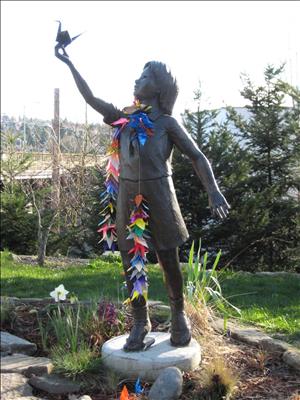On August 6, 1990, dedication ceremonies are held for the Seattle Peace Park. Quaker peace activist Floyd Schmoe (1895-2001) conceived the park as both a monument to world peace and a way to beautify a garbage-strewn, overgrown vacant lot. For the past four years Schmoe has led hundreds of volunteers in cleaning up and developing the small park at the north end of Seattle's University Bridge. The park features a bronze statue, by Daryl Smith, of Sadako Sasaki (1943-1955) holding a folded paper crane. Sadako, who died at age 12 of leukemia caused by the atomic bombing of Hiroshima, made paper cranes an international symbol of peace through her effort to fold 1,000 cranes before her death. The Peace Park dedication marks the 45th anniversary of the Hiroshima bombing.
Floyd Schmoe was an ardent pacifist and peace activist. A lifelong member of the Religious Society of Friends, commonly known as Quakers, he was a conscientious objector in World War I, working in France with the American Friends Service Committee to assist war refugees. In World War II, he gave up his teaching career and scientific research to work full time aiding Japanese Americans interned in what he and many others termed concentration camps. Schmoe was appalled by the atomic bombing of Hiroshima and Nagasaki in 1945 and spent much of the next decade trying to assist bomb survivors. He organized volunteers to build homes for nearly 100 families in the two cities.
A Peace Park for Seattle
Schmoe remained active and involved in peace work well into his 90s. In 1986, inspired, he wrote, by the bumpersticker "Think Globally, Act Locally," on a car in the parking lot of the University Friends Meeting where he worshipped, Schmoe turned to "a problem (which is also an opportunity) on our doorstep" -- the strip of city land directly across the street from the meeting house at the approach to University Bridge (Schmoe papers, 1/54). The steep hillside, located between Pacific and 40th streets, had become an informal garbage dump and was infested with rats and overgrown with brambles, Scotch broom, and other invasive species. Schmoe organized a group of volunteers to clean up the area and began lobbying the city to make it a peace park.
By early 1988, Schmoe and hundreds of volunteers, including a troop of Japanese Boy Scouts, had largely cleaned up the area and begun planting sword ferns, salal, vine maple, and other native vegetation. Navigating the city bureaucracy to win approval for the Peace Park and raising funds to construct it took longer.
The fundraising effort got a boost in November 1988, when Schmoe received the Hiroshima Peace Center's Kiyoshi Tanimoto Peace Award for his home-building work. He devoted the award of more than $4,000 to the park project. A grant from the Fratelli's Ice Cream company funded the statue of Sadako Sasaki, including foundry costs. Sculptor Daryl Smith, who created the statue, donated much of his effort.
Sadako and the Thousand Cranes
Cast in bronze, the life-size figure of Sadako holds aloft a folded crane. When she became ill 10 years after Hiroshima was bombed, Sadako began folding origami paper cranes, attempting to reach 1,000, which according to legend would grant her health. After her death, her classmates raised money for a memorial statue of her in Hiroshima, and along with donations children across Japan sent folded cranes to the memorial. The story of Sadako and the thousand cranes spread widely, making paper cranes a sign of peace around the world. (As recounted in press coverage of the Seattle Peace Park and its Sadako statue, the story went that Sadako had fallen short of her goal of folding 1,000 cranes; more recently, including in a 2018 book he co-authored, Sadako's brother Masahiro Sasaki [b. 1941] has explained that Sadako folded more than 1,000 cranes, continuing to do so even though she did not attain her wish for restored health.)
Schmoe had hoped to have the Peace Park's dedication coincide with the July 20, 1990, opening of the Goodwill Games in Seattle but delays prevented that. Instead, the dedication ceremony took place on August 6, 1990, the anniversary of the Hiroshima bombing.
Floyd Schmoe, who turned 95 a month after the dedication, lived another 10 years, and for much of that decade regularly visited the park he had created, watering and tending the grounds. In December 2003, several years after Schmoe's death, the statue of Sadako was vandalized. Smith was able to repair the damage and the statue was returned the following year. In 2008, Seattle Parks and Recreation renovated the Peace Park, installing new paths, a sidewalk, and a stairway, and making a connection to the Cheshiahud Lake Union Loop, a new trail linking parks and public access points all around the lake.
When the statue of Sadako was repaired in 2004, some of those who raised funds for the repair had urged that it be moved to a more visible location at Green Lake, but the parks department decided that the statue should stay at the Peace Park, where it remains, usually draped in colorful strings of paper cranes.

